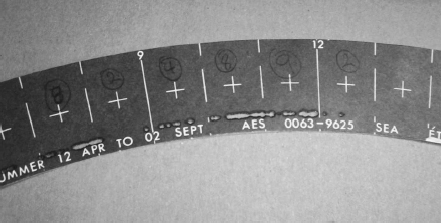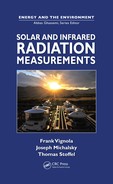Appendix H: Sunshine Duration
The measurement of sunshine hours or percent sunshine was the typical “measurement” of irradiance until the last few decades. This measurement is still made routinely in many parts of the world. A number of ways to estimate sunshine duration are explained in the CIMO Guide (WMO, 2008).
The measurement has been used to estimate global horizontal irradiance using this equation from Ångström (1924):
In this equation GHIo is the global irradiance at the top of the atmosphere, So is the total possible minutes of sunshine during the day, S is the sum of measured minutes of sunshine, and a and b are constants that are empirically derived for each site. These estimates were used when the use of pyranometers was not widespread, but they are of little use today where even low-cost pyranometers make better measurements than the estimates that are possible using Equation H.1. Today, sunshine duration measurements are most useful to cities and resorts that want to promote tourism.
Qualitatively, the sun is shining brightly whenever the shadow of an object can be discerned. The predominant measurement of sunshine worldwide has been the Campbell–Stokes sunshine recorder described in Section 3.3.2. It consists of a glass ball that focuses direct normal irradiance (DNI) on specially treated paper that is suppose to burn whenever the DNI exceeds 120 Wm–2. This is WMO’s (2008) definition of bright sunshine; however, the Campbell–Stokes burns over a range of conditions. For example, in a moist, cold environment, the irradiance will need to be higher before the burn occurs. Figure H.1 is the burn pattern from a Campbell–Stokes sunshine recorder. The handwritten numbers are estimates of the fraction of the hour (measured in tenths) during which there was bright sunshine.
The very best measurement of sunshine duration is made using a reasonably well-calibrated pyrheliometer. There is some discussion concerning the acceptable field of view that a pyrheliometer should have to make this measurement (5° versus 5.7°), but discrepancies from these minor differences are likely to be insignificant.
The next best estimate is made using two pyranometers of the same model and calibrated at the same time. If one is shaded and a shade-corrected value for diffuse derived, as discussed in Chapter 6, then sunshine minutes are tallied whenever.
Akin to this idea, but inferior to it, is the Foster-Foskett sunshine recorder (Foster and Foskett, 1953) that was first used at airports by the U.S. National Weather Service (NWS) in 1953. The NWS appears to have decommissioned these instruments in 2009 (see, e.g., http://www.startribune.com/local/62760757.xhtml, or search for “foster foskett switch”). This instrument used two matched selenium photocells with one shaded and one unshaded. The shade ring was adjusted four times a year; therefore, it was much broader than the typical fixed shade band described in chapter 6. It records a minute of sunshine when the difference exceeds a threshold setting that is manually adjustable on the instrument. Michalsky (1992) compares this instrument’s measurement of sunshine minutes to a nearby measurement using a calibrated pyrheliometer. Although there was a reasonable correlation between the two instruments, the two measurements of sunshine differed significantly compared with two collocated pyrheliometers.
The burn method, employed in the Campbell–Stokes sunshine recorders, is inferior to the first two methods that use a pyrheliometer or two pyranometers, but, as stated earlier, it is still widely used outside the United States. Other methods less often used methods are described in WMO (2008).

FIGURE H.1 (See color insert.) Northern hemisphere summertime Campbell–Stokes measurement of sunshine duration. Fractional hours with bright sunshine are estimated by an analyst and hand recorded.
New instruments have been developed that are probably superior to all methods except the pyrheliometer measurement Two of these newer model sunshine recorders are the MS–093 from EKO Instruments Co., Ltd. and the CSD 3 from Kipp and Zonen.
References
Ångström, A. 1924. Solar and terrestrial radiation. Quarterly Journal of the Royal Meteorological Society 50:121–126.
Foster, N. B. and L. W. Foskett. 1953. A photoelectric sunshine recorder. Bulletin of the American Meteorological Society 34:212–215.
Michalsky, J. J. 1992. Comparison of a National Weather Service Foster sunshine recorder and the World Meteorological Organization for sunshine duration. Solar Energy 48:133–141.
World Meteorological Organization (WMO). 2008. Measurement of radiation and sunshine. In Guide to meteorological instruments and observing practices, 7th ed., WMO-No. 8. Available at: http://www.wmo.int/pages/prog/www/IMOP/IMOP-home.xhtml
